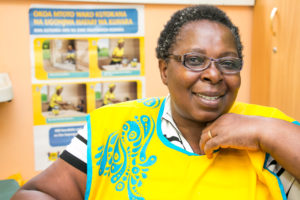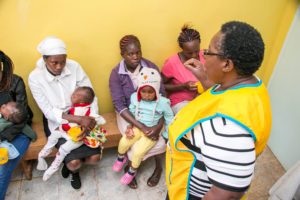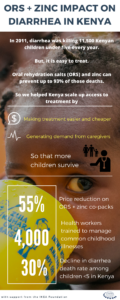In 2011, diarrhea was the leading killer of children under the age of five in Kenya. So the IKEA Foundation, the Kenyan government and CHAI went to work to make treatment more affordable and to train healthcare workers and educate caregivers in order to save the lives of more children. Today, thanks to this work, over 800,000 cases of diarrhea have been averted.
When Elizabeth arrived at Kiambu Level 4 Hospital, an hour’s drive south of Kenya’s capital, Nairobi, she was too weak to walk and her mother carried her in her arms. The 3-year-old was extremely lethargic and had been suffering from diarrhea for two days. She was quickly diagnosed with moderate dehydration, a condition that can turn deadly if not treated properly.

Diarrhea is easy to prevent and treat. Yet it is the leading killer of children in Kenya. In 2011, diarrhea was killing 11,500 children under 5 years old annually. But few caregivers understood how dangerous this illness could be. Dehydration is the main reason children die from diarrhea. At the time, most children were treated at home, often mistakenly with traditional herbs, salt and sugar solutions. Less than half of children suffering from diarrhea were brought to a hospital, and even then, healthcare workers weren’t trained to correctly assess and treat the condition. At that time, Elizabeth would have probably been prescribed antibiotics.
“We had a lot of admissions back then as a result of severe dehydration,” says clinician Immaculate Njoroge. She has worked at Kiambu hospital for over 25 years and is currently in the Maternal and Child Health Unit. On average, she sees 100 children each day. About 15 percent of them have diarrhea.
“Mothers had small pharmacies in their houses, full of all sorts of antibiotics,” she says. Njoroge remembers meeting one mother who had been in and out of several hospitals, and prescribed antibiotics repeatedly, but her child’s diarrhea still wasn’t improving. Njoroge suspected that the child might have developed a resistance to antibiotics.
“Diarrhea was a real burden. It was a very sad situation because a lot of resources were spent to manage the condition…and mothers did not have the right information.”

In 2013, the Kenyan government and the IKEA Foundation partnered with CHAI to try to find solutions.
We focused on closing the knowledge and skills gap for healthcare workers and caregivers, as well as making the appropriate treatments more affordable and easier to use and access.
When it comes to diarrhea, oral rehydration salts (ORS) and zinc sulphate are the most effective treatments. Zinc strengthens the gut lining and reduces the severity and duration of episodes as well as prevents future ones. ORS can be a life-saver. It replenishes electrolytes and quickly rehydrates a dehydrated child.
But, CHAI found that in 2013, less than 40 percent of Kenyan children with diarrhea used ORS and less than 1 percent used zinc. We helped make these medicines easier to access by working with three local manufacturers to co-package the items. Doing this also helped reduce the price of treatment by 55 percent. The government then procured the medicines and distributed them to health facilities.
In Kenya, less than 30 percent of healthcare workers had been trained to use the Integrated Management of Childhood Illnesses (IMCI) strategy. This is a systematic approach to child health, developed and updated by the World Health Organization. IMCI equips doctors and nurses with the skills needed to screen sick children for signs and symptoms that might indicate they have a life-threatening condition that requires immediate action.

Working with the Kenyan government, CHAI trained over 4,000 doctors and nurses to use IMCI over the course of 3 years. Njoroge first received IMCI training in 2003. In 2014, she took a refresher course that CHAI facilitated, and was identified as a potential mentor. She became a trainer herself and was part of the team that trained 615 healthcare workers in her county of Kiambu.
Physical booklets outlining the IMCI guidelines can be difficult to find in Kenya and take time to consult. Based on feedback from nurses, CHAI developed a mobile app of the guidelines for the Ministry of Health. Njoroge says she uses the app every day, with every case she sees. She says she can calculate doses and identify treatments without having to leave her patients. Instead, all the information she needs is right there, in her pocket.
Njoroge and her fellow clinicians can then pass that information on to their patients, both in one-on-one sessions as well as health talks, given to mothers and other caregivers as they wait to receive treatment.
The IMCI strategy stresses that in case of diarrhea, children should receive onsite rehydration therapy. And so, the IKEA Foundation and CHAI helped the government set up over 1,500 oral rehydration therapy corners in health facilities across Kenya.
In Njoroge’s hospital, she says she witnesses “miracles” happening every day thanks to these corners. A triage nurse usually identifies children with diarrhea when mothers arrive and immediately initiates oral rehydration in the therapy corner before the family even sees a clinician.
When Elizabeth arrived at the hospital and was diagnosed with dehydration Njoroge prescribed and prepared the ORS treatment herself. The little girl gulped the drink down and within 40 minutes, she was running around, playing again.
“Such a transformation!” says Njoroge. “We see this every day.”






